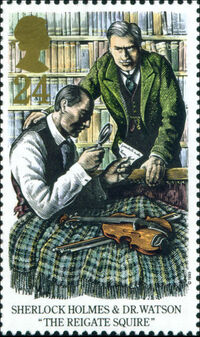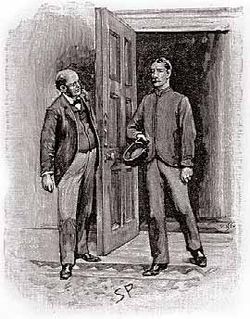
1993 British postage stamp which depicts a scene from "The Reigate Squire".
"The Reigate Squire" (also known as "The Reigate Squires" and "The Reigate Puzzle"; the words "The Adventure of" may also appear before any of those three titles) is a Sherlock Holmes short story by the British author Sir Arthur Conan Doyle. It first appeared in print in the issue of The Strand magazine for June 1893. It would be published again in December of that year as part of the anthology The Memoirs of Sherlock Holmes.
In the story, the brilliant consulting detective Sherlock Holmes is persuaded to take a vacation for his health. He and his friend Dr. John Watson stay at the home of an old friend of Watson's in the Surrey countryside. Shortly after he arrives there, Holmes hears that there has been an unusual burglary in the area recently. The following day, Holmes hears that there has been a murder. The most important clue in the murder case appears to be a scrap of paper with some writing on it that was found in the dead man's hand.
Sir Arthur Conan Doyle included "The Reigate Squire" in a list of his twelve favorite Sherlock Holmes short stories which he compiled for The Strand magazine in 1927.[1]
Plot[]

Holmes, Watson and Colonel Hayter. 1893 illustration by Sidney Paget.
The action takes place in the spring of 1887. Sherlock Holmes has been in France, investigating a case of international financial fraud. The case has been a demanding one for Holmes who has often spent several days in a row working without any sleep. When the case comes to its conclusion, Holmes collapses from exhaustion and is taken to a hospital. After he returns to England, Holmes is persuaded to take a vacation for his health. He agrees to accompany his friend Dr. Watson to the home of Colonel Hayter, an old friend of Dr. Watson who lives near the town of Reigate in the Surrey countryside.
On the first evening that Holmes and Watson spend in Colonel Hayter's home, the colonel announces that he will be taking a pistol with him to bed that night because there was a burglary in the area recently. The library was broken into at the home of a man named Mr. Acton. Curiously, the only items that were stolen were one book (a translation of the works of Homer by Alexander Pope), two candlesticks, a paperweight, a barometer and a ball of string.
The following morning, Colonel Hayter's butler brings the news that there has been a murder at the home shared by Alec Cunningham and his father. The coachman William Kirwan has been shot. One door was forced open but William appeared to surprise the burglar before anything was taken. Holmes finds it strange that the burglars should return to the same area after only a few days. Colonel Hayter, however, thinks that both crimes were probably committed by a local person. He adds that it would make sense for such a burglar to attack the homes of both Mr. Acton and the Cunninghams because they are the two largest houses in the area. Holmes asks if they are also the two richest households. The colonel says that they should be. However, the Cunninghams and Mr. Acton have been involved in a property dispute with each other. Both parties have lost a lot of money pursuing the matter in court.

The older Mr. Cunningham and his son Alec. 1893 illustration by Sidney Paget.
Inspector Forrester, a detective with the local police, comes to the home of Colonel Hayter. He has heard that Sherlock Holmes is in the area and wants to ask for the famous detective's help in investigating the murder of William Kirwan. He gives Holmes more information about the case. According to the Cunninghams' account, the crime took place at 11:45pm. The older Mr. Cunningham had gone to bed. His son, Alec Cunningham, was sitting in his room, wearing his dressing gown and smoking a pipe. Both men heard William's cries for help. Alec ran outside. He saw William struggling with another man and heard a shot. The murderer ran off immediately. Alec comforted the dying William while the murderer escaped through a gap in the garden hedge. From his bedroom window, the older Mr. Cunningham also saw the murderer escape through the hedge. However, neither of the two men are able to offer a description of the killer beyond saying that he was of medium height and wearing dark clothes. The inspector goes on to say that a piece of paper was found in the dead man's hand. A partial text can be seen on the paper, which reads, "d at quarter to twelve learn what maybe".
Holmes accompanies Inspector Forrester to the Cunninghams' house. He later asks Dr. Watson and Colonel Hayter to join him there. In the grounds of the house, Holmes says that the piece of paper is the most important clue in the case so far. The murderer obviously ripped the paper out of the dead man's hand because he knew that it incriminated him. The murderer is probably unaware that he did not take all of the note. The remainder of it is probably still in the murderer's pocket.
Inside the house, Inspector Forrester begins to tell Alec Cunningham and his father about the one significant clue in the case. At that point, Holmes appears to collapse and is taken to the kitchen to recover. Having apparently recovered, Holmes says that the older Mr. Cunningham should offer a reward for information about the crime. The detective writes a reward notice and hands it to Mr. Cunningham. Mr. Cunningham tells Holmes that he has made a mistake. He incorrectly wrote that the crime took place at a quarter to one. Mr. Cunningham changes the note to read "a quarter to twelve" before giving it back to Holmes.

Alec Cunningham and his father attack Sherlock Holmes. 1893 illustration by Sidney Paget.
Holmes says that the burglar may have entered the house before William surprised him. He insists on checking every room to see if anything has been taken. Even though both Alec Cunningham and his father claim to have been in their bedrooms when they heard William cry for help, Holmes insists on checking those two rooms also. In the bedroom of the older Mr. Cunningham, Holmes deliberately knocks over some oranges and a pitcher of water and blames Watson for doing it. Watson, who realizes there was a reason why his friend falsely accused him, begins to clean up the mess. The other men join in with the cleaning. When they have finished, Inspector Forrester notices that Holmes has disappeared. Alec Cunningham and his father go looking for him.
Watson, Colonel Hayter and Inspector Forrester hear Sherlock Holmes cry for help. They find him being attacked by Alec Cunningham and his father. Holmes tells the inspector to arrest the father and son for the murder of William Kirwan.
Holmes later explains the case to Watson, Colonel Hayter and Mr. Acton. He says that he knew that Alec Cunningham was lying in his account of the murder. Alec Cunningham said that the murderer ran away immediately after shooting William Kirwan. This could not be true because the murderer ripped the note out of William's hand after he killed him. The gap in the hedge, through which both Alec Cunningham and his father said that the killer escaped, leads to a ditch with some water in it. The murderer would have left footprints if he went through there.

Holmes explains the case to Dr. Watson, Colonel Hayter and Mr. Acton. 1894 illustration by W.H. Hyde.
The note that was found in William's hand was obviously written by two different people, each one writing alternate words. The reason why they wrote the letter in that way was probably because it concerned something very unpleasant and the two men needed to make it clear to each other that they were both equally guilty. The handwriting indicates that the letter was written by one younger and one older man. Similarities in their handwriting show that they were both from the same family. This makes Alec Cunningham and his father obvious suspects. When he realized that Inspector Forrester was about to tell the Cunninghams about the paper in the dead man's hand, Holmes managed to change the subject by pretending to collapse. Holmes tricked the older Mr. Cunningham into writing the word "twelve" on the reward notice and found it matched the way it was written on the note from William Kirwan's hand. Holmes saw a dressing gown in Alec Cunningham's room. He created a diversion by knocking over the pitcher of water and the oranges. He then returned to Alec's room to check the dressing gown's pockets. He found the remainder of the note to William Kirwan in one of them.
The older Mr. Cunningham made a full confession to the crime. He and Alec broke into Mr. Acton's library, hoping to steal an important legal document related to their property dispute. The document was not there. The two men tried to cover their tracks and make it look like there had been an ordinary burglary by taking objects which were close at hand. William Kirwan saw the father and son break into Mr. Acton's house. He tried to use his knowledge of their crime to blackmail them. The Cunninghams saw an opportunity to get rid of the man by taking advantage of the fear of burglars being in the area.
The note which the Cunninghams wrote to William Kirwan told him to go to the east gate of the Cunninghams' home at 11:45pm. According to the note, he would learn something to his advantage and to the advantage of Annie Morrison. Holmes has to admit that he does not know the precise nature of the relationship between the Cunninghams, William Kirwan and Annie Morrison, a character not referred to elsewhere in the story.
See also[]
Footnotes[]
- ↑ In the list of the twelve best Sherlock Holmes short stories which Sir Arthur Conan Doyle compiled for The Strand magazine in 1927, "The Reigate Squire" is ranked twelfth, following "The Adventure of the Speckled Band", "The Red-Headed League", "The Adventure of the Dancing Men", "The Final Problem", "A Scandal in Bohemia", "The Adventure of the Empty House", "The Five Orange Pips", "The Adventure of the Second Stain", "The Adventure of the Devil's Foot", "The Adventure of the Priory School" and "The Musgrave Ritual".
